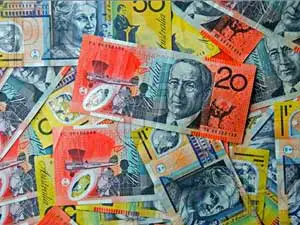Australian Currency Live Real-Time Daily and Historical Chart (Line, Candlestick, Bar, P&F)
Live Real-Time streaming chart of Australian Currency with adjustable line type, time frame/period, and optional technical indicators is available here.
One Month/ Hourly Bar
Australian Currency for Last Month
12 months/ Daily Line
Australian Currency for Last 12 Months
5 Years/ Weekly Candle
Australian Currency for Last 5 Years
Help - How to Use?
Read About How to Use Chart Module
Real-time streaming chart (Australian Currency) can be customized. You can change the time period (1 minute, 10 minute, 1 hour, 1 day or 1 week), time frame (from 10 to 500 time periods), chart type (bar, candle, line, P&F) or change/add technical indicator (Volume, RSI, MACD, Stohastic, Momentum and others); just move your mouse over the chart and notice the Options button in the right top corner of the chart. Click on this button and then adapt the settings according to your needs in the drop menu. You can also Detach the chart in a separate window and zoom it or even make it full-screen.
Do you find this content useful? Like! Tweet! Recommend! Share!
Hallmarks of the Australian Currency
The official Australian currency is the Australian dollar which is symbolized as $ or A$ and is abbreviated as the AUD in the global forex market in which it holds the fifth position as the most traded currency. The responsibility of issuing this currency lies with the Reserve Bank of Australia in form of coins and bank notes of different denominations, with the Australian bank notes being pioneers in the usage of security features as a form of protection against counterfeits. The Australian dollar is a particularly popular option amongst forex investors due to a number of reasons, the foremost being the diversification benefits offered by this currency due to its exposure to the Asian markets as well as the commodities trading cycle.
Evolution of the Australian Currency
Since the island continent of Australia served as a colony for the European settlers in the 18th century, there was no single particular currency which was in circulation. Rather there were a number of currencies and trade often occurred in form of the barter system in which goods and services were exchanged. It was after having gained independence in 1901 that the need for a single currency was felt as a result of which the first official notes of the Australian currency were introduced in 1913 in keeping with the British system. Although there were many exotic suggestions as regards the name of the currency like austral, oz, boomer, roo, kanga and many others, it was finally the wish of the pro-British monarch which determined the name of the currency being pound. This was later changed to dollar in 1965 and the first Australian dollar was introduced on February 14th 1966 as a replacement of the Australian pound to be able to survive till the present era as well.
Inflation/Deflation Affects on the Australian Currency
The Australian currency is one of the exceptional currencies in the forex market which have a marked propensity towards stability courtesy the stable economic and political situation prevailing in the country. When combined with the reluctance of the Government to regulate the mechanism of the forex market, the result is that the value of the Australian dollar has remained immune from inflationary and deflationary trends which have had a profound affect on the value of other currencies. This currency followed a fixed exchange rate system at the time of its introduction in 1966 and was floated for the first time in 1983 when its value was left to be determined by the market forces of demand and supply. Subsequent to this, the value of the Australian dollar has been fluctuating against the US dollar, the fluctuations being particularly strong in the first decade of the new millenium.
Reserve Bank of Australia
The responsibility of issuing the Australian currency and maintaining its value on the global horizon lies with the Reserve Bank of Australia which was established on 14th January, 1960, as the sole bank note issuing authority in the country. Hence, the first objective of the bank is to maintain the stability of the currency through the monetary policies aimed towards controlling inflation. In the bank's opinion this task is best accomplished by maintaining an annual inflation rate of 2% to 3% so that the value of the currency continues to remain stable and free of other pressures. In this way, it also ensures the economic prosperity of the country as well as the welfare of its residents.
Seminal Factors for the Australian Currency

The most influential factor which determines the value of the Australian dollar has been the balance of trade of the country. As an economy, the exports of the country consist mainly of mineral and agricultural products thus implying that it is directly proportional to the value of the currency. Therefore, a global economic boom which results in increased exports causes the currency value to rise and a slump in the prices of minerals and other raw materials causes it to fall. Since the direction of this movement is contradictory to that of the other global currencies, it is one of the reasons as to why the Australian dollar is one of the maximum traded currencies in the world.
Cross Rate Effect
The Australian dollar is one of the few currencies which are open to being paired with any currency in the world irrespective of its country of origin. Although it has not been a part of the most popular currency pair, it is preferred by the forex traders due to its relative stability and versatility both of which provide the forex trader with a number of choices with which he can manipulate his portfolio. Its main competitor being the New Zealand dollar, the Australian dollar could be pitted against any currency like the USD, the Euro or even the JPY as per the prevailing market trend.
Australian Currency and the Forex Market
The value of the Australian dollar in the global forex market has witnessed a sharp rise during the recent times especially after the declaration of the European sovereign debt crisis. The reason behind this unprecedented increase in the value of the AUD has been believed to be the surge in exports of raw materials from Australia particularly to China thus resulting in strengthening of interest rates related to the currency. The currency pair of AUD/USD has been particularly volatile lately making it a risky investment for forex traders as compared to the previous legendary stability of this pair. While many forex traders consider it time to shift to safer trading pairs, a large number of forex traders are still dependent on the AUD for earning consistent profits.
The main concern for the Australian dollar in relation to the financial markets is factors like the internal monetary policy of the country and inflation. Being largely categorized as a commodity currency, the Australian dollar is likely to experience surge in the aftermath of the commodities boom in the global markets. The rise in the prices of commodities is attributed to the increase in the demand of commodities by the emerging and developing economies and apart from the interest rates this is likely to trigger inflation on a worldwide scale as well.
For a good choice of hotels with discount prices, visit Accommodation in Canberra for more information
Real-Time Quotes and Charts Navigator
Are you interested in real-time streaming charts for other indices, stocks, currencies, commodities and other asset classes? Just click on the available links within each asset class...
Select From Real-Time Quotes & Charts Navigator
U.S. Indices: Dow Jones | S&P 500 | Nasdaq 100 | Nasdaq Composite
Europe Indices: Euro Stoxx 50 | FTSE 100 | DAX 30 | CAC 40
Asia Indices: Nikkei 225 | Hang Seng | KOSPI
Currencies: EUR/USD | GBP/USD | USD/CHF | USD/CAD | AUD/USD | NZD/USD
Commodities: Gold | Silver | Light Crude | Brent Crude
Overviews: Custom Stocks Chart | Intraday Overview | Historical Overview | FX Majors
Do you find this content useful? Like! Tweet! Recommend! Share!
Related Articles
ETF Trading Strategies Revealed - Fresh Signals and Ideas Daily
If you are looking for ETF trading strategies, this is the place to be. We provide investing ideas for the most popular ETFs in different categories.
Australia ETF List - Overview and Long/Short Trading Strategies
Australia ETF funds are popular among investors because of country's wealth with natural resources and commodities. Find out how you can benefit!
Written by: Goran Dolenc
Back from Australian Currency to Stock Market Today
Back from Australian Currency to Best Online Trading Site Home Page










